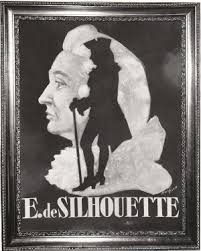 Loading... Please wait...
Loading... Please wait...All prices are in All prices are in AUD
Categories
- Home
- Blog History Revisited
- Shady History of Silhouettes
Shady History of Silhouettes
Posted by Sandra Ker Owner and CEO of the Antiquarian Print Gallery that began in 1989 in Adelaide, South Australia. Dealer in Antique Prints and Maps. on 1st Oct 2015
Regency Era Shade Portraits
I believed the term and technique known as “Silhouette” was a French concept...I was mistaken!
During the Regency Period (1800-1820), portraiture was on of the mainstays of British art. Having a portrait made confirmed one's worth and a status and, consequently recorded one's likeness for posterity. But for 300 years, the expense required for a full colour likeness had restricted that indulgence to the wealthy and kept the ordinary person from acquiring a portable likeness of their loved ones.
The principle of the silhouette was employed on Ancient Greek vases, either in black or red on a black background. (The Georgian, Regency, Empire & Biedermeier Eras were all inspired by Classical Art as reflected in the antique frames of contemporary silhouettes) It was in 1700 that the form of silhouette by which we are familiar, a lack shadow on white background, was established in Britain. their introduction was as “shade portraits” or ‘shadows’ as a cost effective alternative to colour portraits. Consequently achieved great popularity among the more populous classes. However, the black profile made popular by the masses, gradually developed an aristocratic fashionable desirability. Wealthy patrons commissioned silhouettes to be painted and encrusted with precious stones in jewellery. Royalty commissioned porcelain dinner services with silhouettes. All the while common folk filled albums with silhouette likenesses of family and friends.
Etienne de Silhouette the Perceived Cheapskate

It was the French that introduced the term “à la Silhouette”: the surprising origin of this term was a derogatory reference to Louis XV's former French Minister of Finance, Etienne de Silhouette, who was considered a cheapskate. Despite de Silhouette's short tenure as Treasury Chief, he become the subject of hostility. His penny-pinching manner led the term à la Silhouette to be applied to things perceived as cheap or austere. His decision to decorate his home with the English Profile Shades, so it was “Silhouette” was attributed to the British creation.
The aesthetic acceptability was reinforced by intellectual prestige when Swiss Scholar Johann Kaspar Lavater published a study o physiognomy in four volumes 1775-78 from facial features- the art of reading a person's character. It was illustrated thoughout with silhouettes. This was a potent force in spreading the popularity of this style of portraiture.Also the simplicity of the Profiles Shades reflected the neo-classical taste of the era ie the Greek Vase Painting.
Age of the Scissor-Cuts
Although many talented amateurs made silhouettes, professional specialists soon dominated the art. Their methods varied from freehand, to others using mechanical aids in this the age of Industrial Revolution. Lavatier, Swiss physiognomist, designed a "Silhouette Chair". It featured a translucent screen and the sitter's profile was on to the screen so the artist could trace it from behind.Another technique of shadow profile cut from black paper. The great French master cutter, Auguste Amant Constant Fidèle Edouart (1789–1861), worked in England, Scotland and the United States in the 19th century. He specialized and popularized the scissor-cut technique. Edouart felt that the term “shade” was derogatory to his art and began using the term "Silhouettist" to describe himself. The term became popular and carried forward to today.
Antique silhouettes may be found in 4 general forms:
1)Painted on paper, card, vellum, ivory, silk, or porcelain
2)Painted in reverse on glass, a technique called Verre Églomisé.
3) Hollow cut, usually with the aid of a machine but, very rarely by hand. In this process the figure is cut away from the paper thereby leaving a negative image. The backed with a contrasting colour of paper or fabric.
4) Cut freehand with scissors or knives and then pasted to a contrasting (usually light-colored) background. This form of silhouette was often represented at fairs and showgrounds as “Scissor-cutter Silhouettists”. This came to a gradual end as the age of photography took its place.
Evolution of the "Shadow"

In the beginning profiles were all black, taking their form from the solid black shadow of the unadorned individual. Towards the end of the 18th century, artists began to distinguish their works with the barest of bronzing. As the 19th century progressed, the audience demanded more elaborate decoration and the artists obliged with embellishment that became more prominent, depicting jewellery, lace collars, and elaborate hairstyles. In America especially, a group of mostly unidentified artists cut wonderfully naive hollow cut profiles atop painted or lithographed stock bodies.
Silhouettes and Lithography
On both sides of the ocean, artists of the 19th century sometimes applied their cut or painted silhouettes on lithograph or water-colour backgrounds which bring even more attention to the regal simplicity of the shade portrait itself. Here is an superb example by Auguste Edouart recording the wondrous entertaining technology of the day, entitled "The Magic Lantern":the background scene of the projection is lithographed, the silhouettes are added paper-cut silhouettes.
© Sander Ker Antiquarian Print Gallery 2015
Recent Posts
- » Lady Sarah Lennox, King George III & The Honourable George Napier
- » Schomburgk's Botanic Garden & Park Plan, 1874
- » "City of Adelaide" Clipper Ship - What is Old Is New Again
- » Napoleon, Hudibrastic Poetry, Doctor Syntax & the Power of Satire
- » Colonial Melbourne to Albury "Parlour Car" Photo Connects to Adelaide Past & Present








